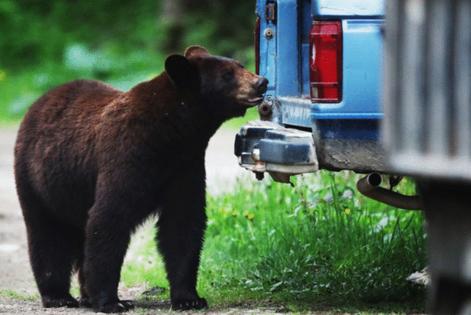More black bears seen in Lower Michigan. Here's how to avoid them, DNR says
Published in News & Features
Black bears are expanding their territory in Michigan's Lower Peninsula and as they roam about, state officials say the best way for residents and bears to both stay safe is to ensure they can't find a reliable snack in their human neighbor's backyard.
The Michigan Department of Natural Resources said while bears have long been a fact of life in the state's Upper Peninsula, they've been venturing farther south and west over the past two decades, including into the Traverse City, Grand Rapids and Midland areas.
The state estimates 2,000 bears now call Lower Michigan home. The DNR has received about 285 bear complaints per year over the past two decades, including 303 in 2024.
Counties with the most such complaints were Marquette (41), Houghton (29), Otsego (26), Chippewa (25), Delta (24), Charlevoix (19), Leelanau (16) and Grand Traverse (13).
About half of those calls came from residents who saw a bear in their yard and wanted the DNR to remove it. However, state officials say a bear simply passing through one's property doesn't necessarily warrant action from state officials.
Black bears are an important part of the state's ecosystem, said Jared Duquette, a DNR wildlife biologist who specializes in human-wildlife interactions.
“Bears eat a variety of fruits, berries and nuts, making them terrific seed dispersers,” Duquette said. “Their droppings help spread seeds across large areas, promoting plant growth and forest regeneration. As opportunistic omnivores, bears help control populations of small mammals and insects. They also scavenge on carrion, which helps recycle nutrients back into the ecosystem.”
Please don't feed the bears
As long as they can't find a meal, bears are not likely to hang around in someone's yard for an extended period of time. To keep the hungry mammals moving along, DNR has two main recommendations:
—Limit or eliminate access to bird feed, including suet, which "is like fast food to a bear." The animals can smell the feed from up to a mile away and remember where it is year after year, DNR said.
—Keep other possible food sources secure. A bear will likely keep moving if there’s nothing tasty around, including unsecured garbage or a food-splattered grill.
If a bear has already helped itself to a tasty birdseed or trash dinner, the DNR will typically recommend the resident remove the food source and give the bear at least two weeks to stop visiting the premises.
Other options include replacing bird feeders with bird baths, securing household trash in a garage or shed, using bear-resistant trash cans (and bear-resistant dumpsters for businesses) and protecting beehives with an electric fence.
“We had a homeowner who wanted us to trap a bear because it was coming by their home every day,” said Stephen Griffith, a DNR biologist for the Traverse City area. “But if a bear is coming by every day, there’s a problem. You need to fix the problem. Bears have a very, very good memory.”
Griffith said two other residents in the Traverse City area decided to leave food out for the bears every day and even named them. This might seem kind, he said, but it's actually dangerous to the bears, which risk getting shot by other residents or euthanized by animal control officers if they continue to frequent areas populated by humans.
“As the saying goes,” Griffith said, “a fed bear is a dead bear.”
The DNR can help remove a bear from a property by scaring it off with rubber buckshot or pyrotechnics. The state can also trap and relocate the animal if it becomes problematic or potentially threatens public safety. A captured bear can be relocated to a more suitable habitat in the woods of northern Michigan but that habitat is becoming scarcer as more land is developed, state officials said.
“You can take a problem bear somewhere else, but then you run the risk of it becoming someone else’s problem,” said Kowalski, whose office relocates about six bears a year.
Don't play dead, don't run away
The black bear is the only species of bear found in the Michigan wild. Despite its name, it can come in three different colors: black, brown and cinnamon. They can weigh anywhere between 100 and 500 pounds.
They generally prefer to avoid people, state officials said, but may defend themselves if they're surprised or feel threatened. Deaths caused by black bears are very rare, with only 61 such deaths across North America since 1900, according to the nonprofit North American Bear Center.
If someone does encounter a black bear, the DNR said, they should not play dead (that will only work on a grizzly) and they should not run away (that can trigger the animal's chase response).
Instead, stand your ground, back away only when the bear stops its approach and make yourself look bigger by raising your arms and jacket, and/or standing on a rock or stump, state officials suggested. One can also yell at the bear loudly and always provide a clear, unobstructed escape route for the bear.
If the bear makes contact with you, fight back, the DNR advises, by hitting, kicking and using anything available like a knife, sticks, rocks, binoculars or a backpack.
_____
©2025 The Detroit News. Visit detroitnews.com. Distributed by Tribune Content Agency, LLC.







Comments